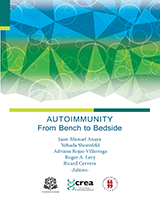From: Chapter 31, Autoimmune hepatitis

NCBI Bookshelf. A service of the National Library of Medicine, National Institutes of Health.
A specific autoantigenic peptide is presented to helper T cells (Th0 cells) within the context of class II HLA molecules together with co-stimulatory molecules present in the antigen-presenting cell (APC). Th0 cells become activated and, depending on the cytokine environment, give rise to different types of effector cells. The presence of IL-4 will allow the differentiation towards a Th2 phenotype featured by the secretion of IL-4, IL-13, and IL-10. These cytokines will favor the maturation of B cells into antibody-producing plasma cells. Antibodies bound to the surface of hepatocytes, in turn, will contribute to cell damage through antibody-dependent NK cell cytotoxicity together with complement activation. The presence of IL-27, IL-12, and IL-23 promote the differentiation of Th1 cells. The latter ones secrete IL-12 and IFN-γ which stimulate CD8 T cells, upregulate the expression of class I molecules, and induce the expression of class II molecules on hepatocytes, thus exacerbating the inflammatory process. TGFβ, IL-21, and IL-6 promote the differentiation of Th17 cells which secrete the pro-inflammatory cytokines IL-17A and IL-17F. Treg cells, which are specialized in suppressing responses to autoantigens, undergo differentiation under the influence of TGFβ and IL-10. In spite of the large number of Treg cells found in the livers of patients with AIH, their presence is not enough to hamper the damage to the liver. The latter finding suggests the participation of inflammatory mediators in the local milieu, such as IL-21, which hinders the normal functioning of this cell type.
From: Chapter 31, Autoimmune hepatitis

NCBI Bookshelf. A service of the National Library of Medicine, National Institutes of Health.